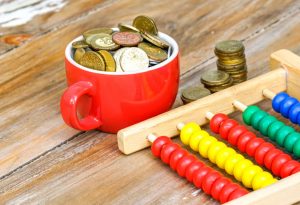In this Article
- What is Abacus?
- Benefits of Abacus for Kids
- How to Use Abacus for Children?
- Counting and Basics with Abacus
- How To Teach Addition With The Help Of Abacus
- How To Teach Subtractions With The Help Of Abacus
- Teaching Money with Abacus
- Teaching Multiplication with Abacus
- Use of Abacus to Teach Place Value
- How to Make An Abacus for Your Child at Home
One of the most successful methods through which toddlers and children learn is touch, feel and colours. It imprints easily in their minds. Hence, objects become a convenient method to teach children. Now, imagine if such an object can be used to teach maths!
Abacus makes maths easy to comprehend and fun to learn.
What is Abacus?
The Latin word ‘abax’ from which the word abacus is derived means a flat surface or table. Today, abacus has evolved into a framed wooden object with strings of plastic or wooden beads. The ancient abacus was a flat board or tablet on which stones or shells were moved in order to calculate. It was only in Rome that a metal abacus originated similarly to what is used these days. Abacus has an origin in countries like Europe, China and Russia but its exact time of origin is unknown.
History of Abacus
You know of the abacus as a calculating tool that was used before written numbers were invented. People wanted to communicate calculations to each other, and hence abacus was used. Though it is a vintage form of calculating, Abacus is used to introduce maths to children in the modern world.
Benefits of Abacus for Kids
Some of the benefits include:
- As they are required to retain information in their brains, an abacus helps develop a strong memory.
- An abacus requires not only mental cognition but also a certain amount of motor skill functions, activating different parts of the brain.
- It helps the brain visualise calculations rather than seeing them as mere words. This provides a core for future learning through visualisation.
- Figuring out sum through an abacus is no small feat and is guaranteed to help improve your child’s concentration.
- The foundational mathematical operations like addition and subtraction can be learnt effectively through an abacus.
- Studies have shown that high-level mathematics can be tackled by an abacus user with better results compared to a non-abacus user.
- As your child gets better in math, their confidence increases dramatically.
- After regular usage, a child will have a mental abacus that they will use to solve mathematical problems. This method of visualisation helps them derive logical answers in everyday situations.
How to Use Abacus for Children?
There are many Abacus activities one can use to train their children. These games and activities differ for each age group. However, this list of games is popular due to its lack of complications and easiness to understand.
The things you need for this are:
- A simple, colourful abacus
- Your patience and interest
The ‘Match My Move’ Method
- Begin with placing all the beads of each row on one side of the abacus. You will have the other half of the row empty.
- Ask your child to observe your next step closely and slowly move a bead to the other side, ask your child to imitate you. Make sure that they do the same move.
- Now, in the next row move a few more beads and ask your child to do the same. Make sure that they shift the exact number of beads to the other side.
- Repeat the process; please be vigilant to help the child make no mistakes in counting the exact number of beads shifted.
- To keep it interesting, do not go in ascending or descending order but shuffle the numbers of beads you shift and the rows that you play with.
- If the child has got the knack of it, advance the game by shifting sides.
- Make sure you do this slowly especially if your baby is a toddler. You also have the option of using sound by counting the numbers out loud for the toddler. Make it as interesting as possible for little children.

The Counting Game Method
- Move beads from right to left (or the other way). Do this slowly, so that your child can observe how many beads you have shifted and how many you have left behind.
- Make sure there is space in the middle of the row to shift the beads if and when required.
- Ask the child to move the exact number of beads to the other side and count the number of beads moved. Now, urge them to count the number of beads left behind.
- Ask the child to count the total number of beads by shifting them to the centre.
Counting and Basics with Abacus
Some of the basics involved in an Abacus include:
- Ensure that the bead placement is correct
- Make sure you assign a value to each column
- Moving one bead upwards counts as one, two beads as two and so on
How To Teach Addition With The Help Of Abacus
There are multiple levels of additions that can be used on an Abacus:
Addition
We need to add value to every bead. The basic ways to begin would be to give the value of one to each bead. Let’s learn this as an example.
3+2= 5. This example can be done on the abacus in this manner:
- Shift all beads to one side (preferably left)
- Now, shift three beads to the right, leave one finger space and shift two more
- Ask your observing child to add the value by shifting the two beads towards the first three. The sum would be five which is the answer.
Advance additions
Abacus is like Vedic mathematics, it has less to do with counting and more with strategies. These strategies are the key to evolving thinking, memory and other aspects of mental ability. For advanced additions of the abacus, the following simple strategies will help:
The 10s strategy
Example: 6+9=15
- Make the child shift six and nine beads from the first two rows respectively.
- Now, to make it an easier method of calculating, make them shift one bead from the row of six and thus making it five and add one more to nine thus making it 10. Voila! We have the fifteen that’s easier to mentally calculate.
The Two 5s Strategy
Example: 7+6=13
- Shift seven beads on the first row and six from the next.
- Keep a finger space after the last two beads of the seven beads and the rest.
- Keep a finger space between the last bead of the six and the rest.
- Now, what you get is five in each of the rows, simple add three to the count of ten
- This can be done with any number higher than five.
How To Teach Subtractions With The Help Of Abacus
This is as easy as additions. In fact, easier.
Example 8-6=2
- Make the child shift 8 beads to the right.
- Acknowledge that it is minus and hence, further beads need to be removed and not added.
- Urge the child to shift 6 beads back to the rest of beads.
- The child understands that the leftover two beads are the result of 8-6. i.e. 2.
Teaching Money with Abacus
It is interesting to teach children about the Indian currency with the abacus. A clear way of learning the value and the multiples of the currency.
- Keep a one rupee coin, two-rupee coin,5-rupee coin, 10 rupee note, 20 rupee note,50 rupee note and a 100 rupee note on display.
- Part the ten rows into two halves.
- Keep the value of the 100 beads as 100 rupees thus allocating the value of one rupee to each bead.
- Now show the one rupee and explain that each bead is equal to that, two of the beads is equal to a two-rupee coin, the five beads of one string become 5 rupees, and two sets of the five in one section are ten. The whole section of fives become the fifty, both the fifties together becomes 100 rupees note.
- Once the child gets this, the value can be shifted to 1000 rupees and each bead worth 10 rupees.

Teaching Multiplication with Abacus
We have all been textbook learners of multiplications, that is we have mugged the whole tables! Abacus has a different approach; it shows that multiplication is nothing but the sum of a particular number twice, thrice and so on.
Example:4*4=16
- Make the child shift four from four rows to the other side
- Urge your child to count the four fours
- The sum of which will be 16. Hence the child becomes aware that 4*4 is nothing but 4+4+4+4
Use of Abacus to Teach Place Value
If we require to teach beyond the simple value and use it to make them understand place value it can be done in simple and easy manner.
- Simply increase the value of the bead from one on each row.
- The first layer represents 0-9 with the value of 1 for each bead.
- The next represents 0-90 and value of each bead is 10.
- Lastly the third row with 0-900 with the value of 100 for each bead.
How to Make An Abacus for Your Child at Home
If you would like to try making an abacus at home to go one step more and give the child an experience of craft, it could be done in five easy steps:
What Will You Need?
- Four big candy sticks or craft sticks
- Five trim skewers or popsicle sticks
- 50 beads, ten of each colour
- glue
How To Do It
- Mark five equal distance lines on the four-candy stick and stick the five popsicle sticks on it (lying down).
- Place another candy stick with the glue measurements on top of the stuck popsicles. The sticks must be sandwiched between these two candy sticks.
- Let it dry.
- Make the popsicle sticks stand horizontally with the pen end on top.
- Thread the same coloured beads of ‘ten’ to each row.
- Now close the open end with the third and fourth candy sticks with glue measurements.
- Once both the sides of the popsicle sticks are sandwiched with the beads in them, your minute simple abacus is ready.
The Abacus becomes intriguing once kids and you learn the methods of playing or working on it. These methods can be worked on a simple single coloured Abacus or a two-coloured beads abacus. Remember that any activity or any game that you play with children your interest is a reflection of how much interest they will have in the same.









